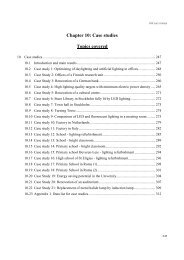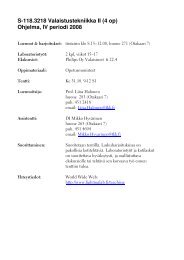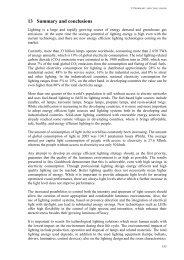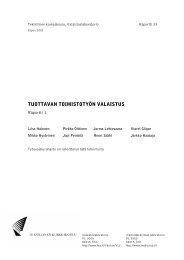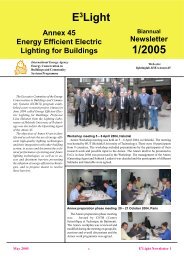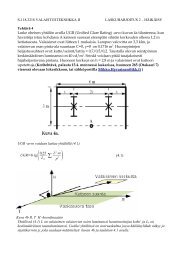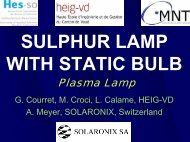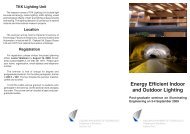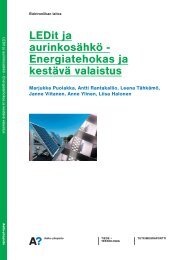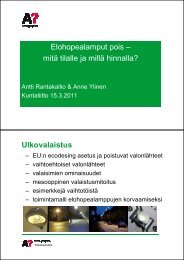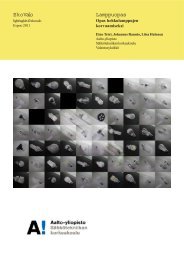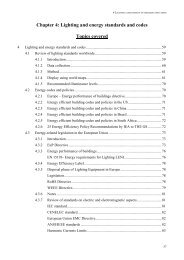LIGHTING SYSTEM ANALYSIS IN THE UNIVERSITY BUILDING ...
LIGHTING SYSTEM ANALYSIS IN THE UNIVERSITY BUILDING ...
LIGHTING SYSTEM ANALYSIS IN THE UNIVERSITY BUILDING ...
Create successful ePaper yourself
Turn your PDF publications into a flip-book with our unique Google optimized e-Paper software.
Silesian University of TechnologyFaculty of Electrical Engineering, South-East facade4
Silesian University of TechnologyFaculty of Electrical Engineering, auditorium5
Silesian University of TechnologyFaculty of Electrical Engineering, classroom6
Luminaires positions on the 3-rd floor, leftside7
Daylight• South-Eastrooms are very well illuminated withthe daylight, the average illuminance in the workplane is about 600 lx; in the biggest auditorium180-420 lx; the artificial light is usually switchedoff in the daytime,• in every South-Eastroom there are blinds,• North-Westrooms are dark and it is necessary touse artificial light all the day,• number of users: about 1000 students and 100lecturers.8
Light sources• 1029 linear fluorescent, installed power 39470 W(with electromagnetic ballastast 2W)• 54 compact fluorescent, installed power 1193 W,• 126 incandescent conventional, installed power19800 W• 32 halogen, installed power 2630 W• 3 reflector incandescent, 130 W• 8 mercury and sodium (outside),, installed power,1910 WTOTAL <strong>IN</strong>STALLED POWER: 65 193 W9
Luminaires in building10
Luminaries in building• very simple luminaries with incandescentlamp,• fluorescent lamps with electromagneticballasts (2 W/lamp) – in corridors withoutreflector, in classrooms raster,• compact fluorescent lamps, , halogen lamps• no dimming,• power densities from 2,33 W/m 2 (somecorridors) – 22 W/m 2 (roomswithincandescent lamps).11
Illuminances on the work plane, 1-st floor,right side12
Illuminances on the work plane,auditorium 61513
Illuminance measurements• in the most of rooms the illuminance is belowstandard,• the best situation is in the classrooms andauditoria, , but in the workers rooms it is necessaryto use additional local lamps,• uniformity ratio in the most of rooms: : 0,5-0,7,0,7,• the most of luminaries should be exchanged intomore efficient.14
Working time• 9 month observation (2005/2006),• the most of rooms and classes are occupiedsince 8.30 am to 6-86pm except weekends,• in the nights (10p.m.-8a.m.)andholidays/weekendsthe selected lamps incorridors are switched on.15
Energy consumption• total energy consumed in the building – 99,4MWh/yearyear,• energy consumed for lighting – 37 % of the totalelectric energy used in the building (37,45MWh/yearyear)• fluorescent lamps with ballasts 22,66 MWh/year–60,5%,• sodium and mercury lamps 7,28 MWh/year–19,44%,• incandescent lamps 7,51MWh/year– 20,05%16
Energy saving potential• exchange of the incandescent lamps into campactfluorescent ones - about 6,44 MWh/yearyear,• exchange of the old fluorescent lamps (ø 38 mm) into newø 26 mm – 1,44 MWh/yearyear,• exchange of the outside lamps (mercury, sodium) intomore efficient – 3,93 MWh/yearyear,• total energy saving potential: : 11,81MWh/year(31,5% ofthe total electric energy consumed for lighting),• the real total energy saving potential might be lowerbecause of the not enough illumination in many palces andto low uniformity value,• exchange of the nonefficient luminaires is the must.17
ENTE Ltd. – IT enterprise18
ENTE Ltd. – IT enterprise19
ENTE Ltd. – IT enterprise20



